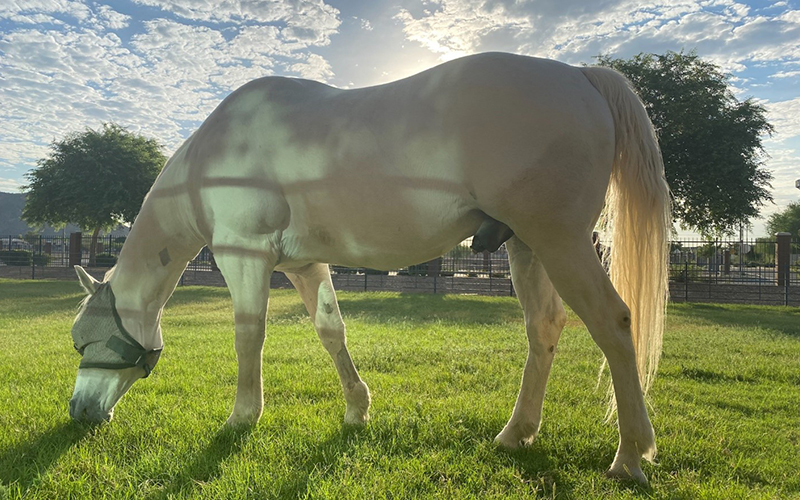Equine Metabolic Syndrome

What is Equine Metabolic Syndrome?
Equine Metabolic Syndrome (EMS) is a combination of three abnormalities: obesity, laminitis, and insulin dysregulation.
- Obesity is when a horse is extremely overweight. Sometimes it is because these horses are fed too many calories, but often it is because they are evolutionarily extremely efficient with feed. What is an entirely appropriate diet for a Quarter Horse or a Thoroughbred is a diet that might make an Arabian, Mustang, or Tennessee Walking Horse overweight.
- Laminitis is also known as 'founder.' Laminae are the tiny little attachments that hold a horse's coffin (foot) bone inside its hoof. Horses' bones do not touch the ground and are suspended inside their hooves. Laminitis is an incredibly painful disease of the feet where the laminae weaken and stretch as the horse's weight pushes the bones down, rotating and sinking inside their hooves. Laminitis can be life-threatening.
- In these horses, insulin dysregulation is the cause of laminitis. When a horse eats a meal, the pancreas releases insulin to help process the sugars. In obese or predisposed horses, insulin is released but stays at a very high level for a long time instead of a typical minor release for 30-60 minutes after eating. High blood insulin levels for a prolonged time can cause laminitis.
What are the signs of Equine Metabolic Syndrome?
Early in the course of the disease, a young horse or pony would be termed “an easy keeper.” Other than being a bit overweight, there would be no apparent signs. As time passes and the horse gets heavier, there can be sneaky or subclinical laminar stretching with no obvious signs of lameness. An observant farrier or owner may notice subtle widening of the white line at the toe (where the toe sole meets the hoof wall) or slight dishing (curving outward) of the front hooves. As the disease progresses, the horse becomes clearly sore on its feet and unwilling to move. Often, local fat deposits develop with a ‘cresty neck’ or ‘saddle bags’ of fat on their sides.
What tests are required?
A diagnosis of Equine Metabolic Syndrome is based on diet history, physical examination, body condition score, radiographs of the front feet, and an insulin level. Most commonly, insulin levels are checked after a regular hay meal and are markedly elevated. Sometimes, horses will be fasted overnight (feed withheld) to see how low the insulin gets with no food and how it responds when a specific syrup (sugar) is administered. This is called a glucose tolerance test.
What is the treatment?
A low carbohydrate diet, weight loss, and regular farrier care are the mainstays of treatment. A low carbohydrate diet measures less than 10% in water-soluble carbohydrates (sugars) and starch. Teff hay was designed for the insulin dysregulated horse, but many grass hays often test well. Hay can be sent for testing and your veterinarian can interpret the results.
Weight loss can typically be achieved by feeding 1.5% of the goal body weight. So, if your horse weighs 1200lbs and should weigh 1000lbs, it would need a total of 15lbs of feed daily. Exercise is fantastic for weight loss, but some horses are so painful on their feet that they cannot exercise. We also have medications that can be used for short periods to help these horses lose weight and control their insulin response to food.
What is the prognosis for horses with Equine Metabolic Syndrome?
The prognosis varies based on how early the disease was caught, how dedicated owners are to the husbandry after diagnosis, and somewhat on luck. Some horses respond beautifully to weight loss and dietary management, while others get stuck in a painful cycle. A Board-certified large animal internal medicine specialist working with your veterinarian can be helpful in these difficult cases.
What can you do to prevent infection?
The best treatment is prevention by maintaining an ideal body condition. Please work with your primary care veterinarian on learning about body condition scoring and adjust your horse’s diet accordingly.
Articles by Specialty
- Cardiology (18)
- Large Animal Internal Medicine (23)
- Neurology (16)
- Oncology (20)
- Small Animal Internal Medicine (25)
Articles by Animal
- Cats (35)
- Dogs (47)
- Farm Animals (5)
- Horses (12)
